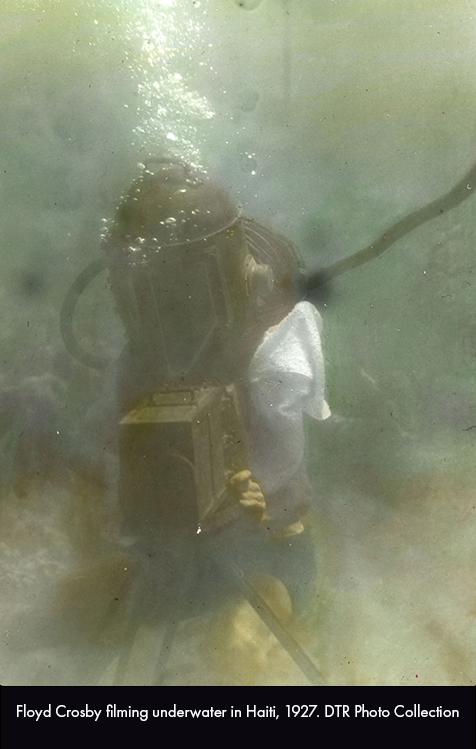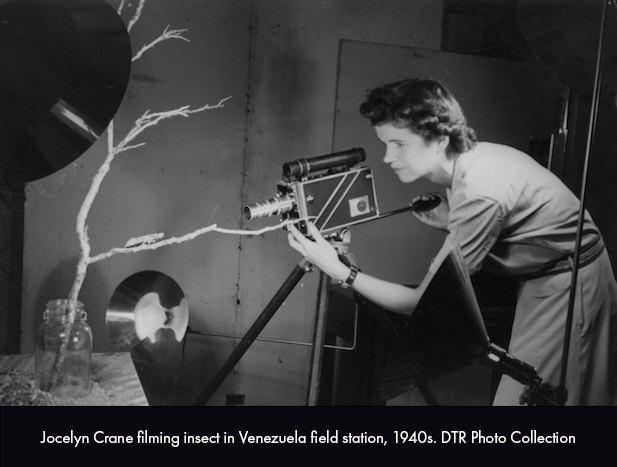History of the DTR Film Collection
Between 1916 and 1964, the New York Zoological Society (NYZS)’s Department of Tropical Research (DTR), led by William Beebe (1877-1962), undertook dozens of ecological expeditions across tropical terrestrial and marine locales. Conducting what is now regarded as standard ecological research, the DTR were among the first Western scientists to study the interconnectedness of tropical wildlife and their habitats through close, first-hand observations. The DTR were additionally noteworthy in that they were composed of both men and women, and included not only scientists but also artists, writers, and filmmakers. This multidisciplinary approach was crucial to their mission of disseminating their findings beyond the scientific community to the public.
Film played a key role in this effort, serving both as a research tool and as a means to engage and educate the public. The DTR utilized film to enhance lectures for both technical and general audiences, produced films for NYZS members, and even released some as newsreels. The earliest films in this collection date back to the early 1920s when expeditions would set sail from New York with thousands of feet of 35mm black-and-white film, as noted in the 1923 NYZS Annual Report. The unfamiliar shooting conditions necessitated a substantial supply of film to capture rare and potentially unique scenes. Over the following decades, the DTR would continue to include motion picture film and cameras as crucial supplies for their expeditions.

The allure of these expeditions attracted two filmmakers who served as DTR staff cinematographers and would later achieve notable success in Hollywood. In 1925, Ernest Schoedsack, later the director of King Kong (1933), accompanied the DTR—including his future wife and collaborator Ruth Rose—on the steam yacht Arcturus to the Galápagos Islands. Floyd Crosby, before he became an Academy-award winning cinematographer for Tabu: A Story of the South Seas (1931), first travelled to Haiti in 1927 with the DTR. Using a handcrafted underwater housing unit for his movie camera, Crosby captured footage of coral reefs and their inhabitants.
Beyond these notable filmmakers, other DTR staff honed their skills behind the camera to document and communicate their work. Jocelyn Crane, who joined the DTR in 1930, was especially prolific, shooting hundreds of feet of color 16mm film in her studies of insects in Venezuela and Trinidad and of fiddler crabs across the world. Crane’s footage features prominently in the edited films among the collection, including Curioseando en la Selva (1948), Color on the Wing in Trinidad: Butterfly Studies at the Society's Tropical Research Station (circa 1953-1956), and Along African Shores in Search of Fiddlers (1957).

For more on the history of the DTR, please see the WCS Archives' DTR Expedition Illustrations site. A selected history of DTR expeditions appears in this collection's finding aid. For more on the WCS film collection, please see the WCS Archives' Film Collection site.
CONTENTS OF THE DTR FILM COLLECTION
The Department of Tropical Research Film Collection is composed of 156 film reels, including duplicates. Formats include black-and-white and color motion pictures; the majority are silent, 16mm, acetate films. The films in this collection were created by various Department of Tropical Research members, indicated in the finding aid's item-level notes where known. They were shot between the early 1920s and 1966 in various locations, including Bermuda, Guyana, the Eastern Pacific Ocean, the Galápagos Islands, the Gulf of Mexico, Haiti, Malaysia, the Philippines, Singapore, Tanzania, Trinidad, and Venezuela. Much of the collection, which is primarily composed of unedited footage, shows DTR members at work and the wildlife subjects of their studies. Among the footage is rare and possibly unique documentation of landscapes, wildlife, and local people.
In both the finding aid for this collection and the metadata accompanying the digitized films, the WCS Archives has attempted to provide as much information as possible , including identifications for people who created or are depicted in the films. Most of the time, those identified are the US-based DTR staff; none of the existing documentation identifies by name local people who appear in the film, some of whom were essential contributors to the DTR's production of scientific knowledge. While the DTR relied on the knowledge, expertise, and physical labor of people who inhabited the countries in which they worked, those individuals went largely uncredited by the DTR. Today, while we have identified the names of DTR staff on this site, we also recognize the critical work of the many whose names are unknown to us now. If you have further information about the contents of these films, including details about people shown, we would be glad to hear from you.
ACCESSING AND USING THE COLLECTION
64 items in this collection have been digitized and are available online. Items not digitized are duplicates of items that were digitized or had condition challenges preventing their digitization. A few digitized items have not been made publicly accessible because they contain sensitive footage of children.
For questions about licensing the films for use, please contact library@wcs.org.